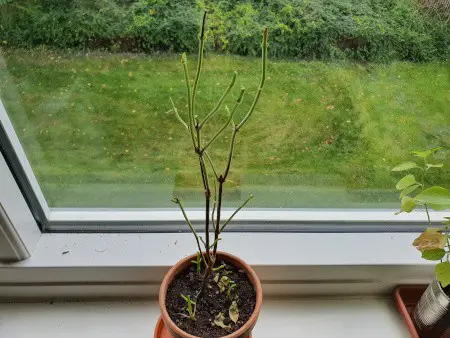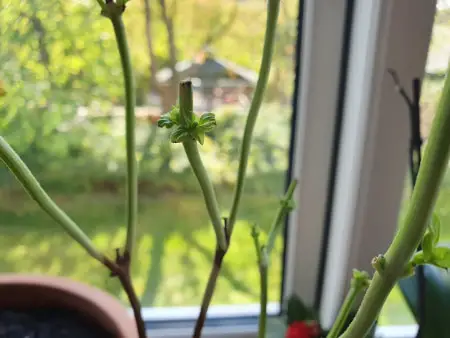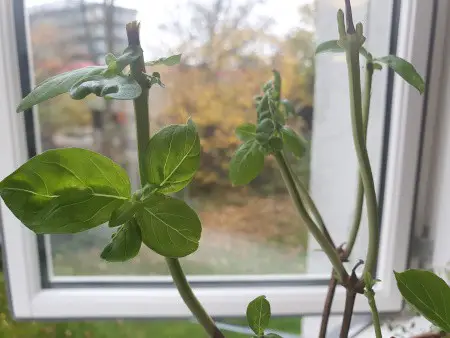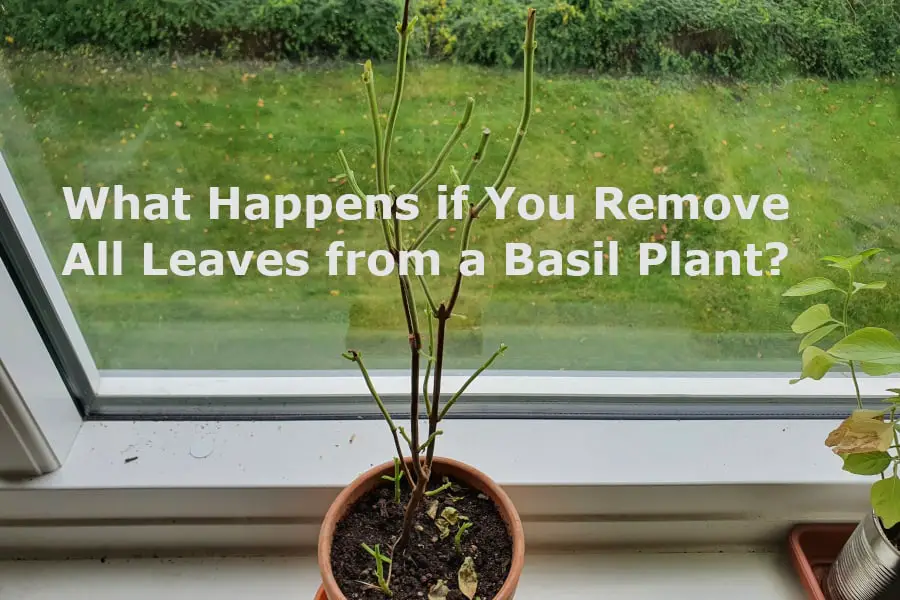Did your basil plant lose all its leaves, and are you wondering if it can survive? That happened to me with a few plants, and I managed to save one of them. I wrote this post for those of you who are in the same situation as I was.
Basil plants can sometimes survive without leaves, although it takes a while for new leaves to grow, and in some cases, they won’t, and the plant will die. Large plants are much more likely to recover than small plants, and 6-8 hours of sun and consistent watering will further increase the chances of recovery.
If your basil plant doesn’t have any leaves, it might not survive, but after doing some experimenting with a few of my own basil plants, I learned about some things that can make them a lot more likely to survive.
I share what I did to bring one of my basil plants back to life after it lost all its leaves below.

Tips to Help Basil Survive After Losing All Leaves
If your basil plant has no leaves, it is definitely easier and faster to just buy a new one at a plant nursery or a supermarket, but if you really want to bring it back to life, you probably can.
I did, and it actually worked better than I expected, although it took a while. At the end of this post, I share a couple of photos of my plant throughout the process, so you can see what to expect and how long it takes.
While trying to bring my basil plant back to life, I learned these great tricks that you can also use to bring yours back to life if it lost its leaves.
Big plants have better chances
- Basil plants that are big and well-established have a much higher chance to survive without leaves than small, young plants. Young plants are unlikely to recover at all.
I had four plants in a pot, all without leaves. A big and well-established plant and three that were much smaller and younger because I planted them later. As you will see in the photos later in this post, only the big plant survived and produced new leaves.
Big plants have better chances to survive without leaves than small plants because they have more extensive root systems that can obtain water and nutrients more efficiently, which can sometimes keep the plant alive until new leaves start to grow.
Cut above fresh leaf nodes
- Cut all stems about 0.5 inches (about 1 cm) above the freshest looking leaf node.
The easiest way to find the right leaf nodes is to look after the light green ones. If they are brown, it is unlikely that new leaves will grow from them.
So all you have to do is to find the greenest, freshest-looking leaf nodes on each stem and then cut right above them.
Give your plant plenty of sunlight
- Basil needs to be in direct sunlight for new leaves to grow, so to increase the chance that your plant will survive and grow new leaves, place it in a sunny spot. 6-8 hours of sun per day is ideal.
I have written another post where I go more in-depth with how much sun basil needs, but the most important takeaway is that your plant needs 6-8 hours of sun per day, but no more than that since it can damage the plant.
If there isn’t enough sun, you can use grow lights to provide your plant with some grow light. It can actually work really well.
Keep the soil moist
- Basil is fragile without any leaves, so one of the most important things is to keep the soil consistently moist. It should not be dry but also not wet.
In my experience, this is something bigger basil plants are a lot more resistant to than small plants. Of course, no matter how big the plant is, being in too dry or too wet soil will eventually kill the plant, but big plants can last longer than small ones.
Correct watering is the key to this. I have a guide about that on this link.
I did an experiment to show you precisely what happens when you remove all the leaves from a basil plant and how long it takes the plant to grow new leaves.
My Experiment: Can Basil Grow Back Without Leaves?
I wanted to know if basil would survive and grow back if it didn’t have any leaves, so I thought the most reliable way to find out was to test it for myself.
I had four basil plants growing in a pot. One of them was big and well-establish, and the other three were young and small. I removed all the leaves from the plants to see if they would grow back and how long it would take. I made sure to get some photos along the way, so you can see how it looks and how long you can expect it to take.
The result of my experiment was that the big basil plant survived and grew new leaves, but the three small plants did not.
Here is how it went:
Day 0

I took this photo just after I removed the leaves. As you can see, there is one big plant and 3 small ones that were planted later in the same pot.
Day 7

Small leaves started to appear on the big plant. The small plants still show no signs of recovery.
Day 30

The big plant is doing well. Many leaves are growing and reaching their full size. One of the small plants is completely dry and the two other small plants also look like they are dying.
Overall, the experiment went better than I expected. Sure three of the plants died, but the three that did, were young and small, so I didn’t expect them to survive.
I was surprised to see how well the big plant recovered. The leaves look a little bit odd, but the plant is doing great overall, and the leaves are growing every day now. It took a month, but it worked.
What Happens if You Remove All Leaves from a Basil Plant?

Removing basil leaves is actually one of the most efficient ways to encourage growth and increase the overall yield from the plant, but only if you do it right. If you do it wrong, it can damage your plant.
Removing leaves only encourages growth if you don’t remove too many at the same time. If you remove all the leaves from a basil plant, or if the plant lost them some other way, it will have a tough time recovering because it needs the leaves to absorb sunlight.
Removing all the leaves from a basil plant will cause it to stop growing because it can no longer absorb sunlight. If the plant is big, there is a chance it will grow new leaves, but if the plant is small, it is unlikely to survive. Therefore, it is best never to remove all the leaves from a basil plant.
The short explanation of how to properly harvest basil leaves is that you should cut the stem just above the newest set of leaves. That makes the stem split in two and produce twice as many leaves. A longer explanation can be found here.
Read My Complete Guide to Growing and Caring for Basil
I have written a thorough guide where I cover all parts of growing your own basil including choosing a variety, sowing the seeds, the best growing conditions, pruning, propagation, harvesting, storing, solving various problems, and a lot more. You can find the article on this link.
